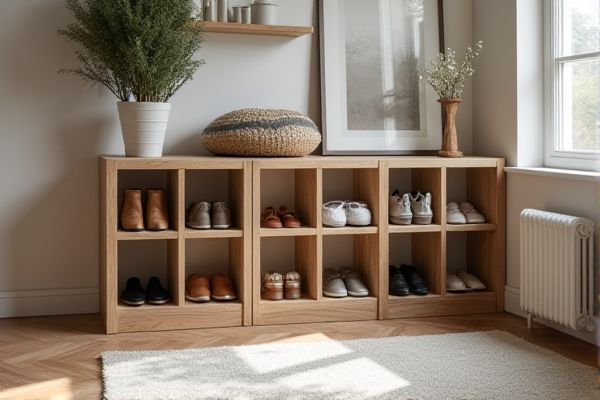
A shoe cubby offers individual compartments that keep your shoes organized and easily accessible, while a shoe basket provides a simple, flexible container for quick storage but may lead to clutter. Discover which option suits Your space and lifestyle by reading the rest of the article.
Table of Comparison
| Feature | Shoe Cubby | Shoe Basket |
|---|---|---|
| Design | Individual compartments for each pair | Open container, holds multiple shoes loosely |
| Organization | High, separates shoes neatly | Low, shoes can get mixed |
| Space Efficiency | Maximizes vertical storage | Requires more horizontal space |
| Capacity | Fixed, based on number of cubbies | Flexible, depends on basket size |
| Material | Wood, plastic, or metal commonly used | Plastic, wicker, fabric, or metal |
| Accessibility | Easy to find specific shoes quickly | Requires sorting through shoes |
| Best Use | Organized shoe storage for multiple pairs | Casual storage or transport of shoes |
Introduction: Shoe Cubby vs Shoe Basket
A shoe cubby offers organized compartments that keep each pair neatly separated, making it ideal for maximizing space and easy access. Shoe baskets provide a versatile, portable option for storing shoes but lack the structured separation that helps prevent clutter. Choosing the right storage solution depends on your space and organizational needs for maintaining a tidy entryway.
Design and Structure Comparison
A shoe cubby features multiple individual compartments designed to separate and organize shoes neatly, offering easy access and visibility. Shoe baskets, often made from woven or flexible materials, provide a single large open space suitable for quickly storing various footwear without distinct sections. The rigid framework of cubbies ensures stability and shoe protection, whereas baskets prioritize portability and casual storage.
Space Efficiency and Storage Capacity
A shoe cubby offers superior space efficiency with individual compartments designed to store shoes neatly, maximizing vertical storage capacity and reducing clutter. In contrast, a shoe basket provides more flexible storage but often lacks structured organization, which can lead to wasted space as shoes pile unevenly. Choosing a shoe cubby can enhance your shoe storage by utilizing every inch effectively, especially in tight spaces.
Accessibility and Convenience
Shoe cubbies offer individual compartments that enhance accessibility by allowing you to quickly locate and retrieve your shoes without disturbing other pairs. Shoe baskets provide a more casual storage option but can make finding specific shoes less convenient due to the mixed grouping. Your choice between the two should consider how often you need easy access and organized separation for your footwear.
Aesthetic Appeal and Style
A shoe cubby offers a sleek, structured design that enhances organized spaces with a modern, minimalist aesthetic, making it ideal for showcasing your shoe collection neatly. In contrast, a shoe basket provides a more casual, rustic appeal with woven textures that add warmth and softness to room decor. Your choice between a cubby and a basket can significantly influence the overall style and visual harmony of your entryway or closet.
Material Durability and Maintenance
Shoe cubbies typically feature solid wood or metal construction, offering superior durability and easy maintenance through occasional dusting or wiping. In contrast, shoe baskets are often made from woven materials like wicker or fabric, which may be less durable and require more frequent cleaning to prevent dust buildup or wear. Choosing a shoe cubby ensures longer-lasting structure and simpler upkeep, preserving the organization of Your footwear collection.
Organizational Benefits
Shoe cubbies offer compartmentalized storage that keeps each pair neatly separated, preventing clutter and making it easier for You to find the right shoes quickly. Shoe baskets provide a flexible, open space ideal for temporary or bulky shoe storage, promoting quick cleanup and maximizing floor space. Both options enhance your home's organization by reducing mess and streamlining shoe management.
Suitability for Different Spaces
A shoe cubby offers structured compartments ideal for organizing shoes in small entryways or closets, maximizing vertical space efficiently. A shoe basket provides flexible storage, fitting well in larger or open areas where you prefer a casual, easy-access solution for your footwear. Your choice depends on space size and the level of organization you want in your home.
Budget Considerations
Choosing between a shoe cubby and a shoe basket largely depends on your budget and storage needs. Shoe cubbies usually offer more organized compartments at a higher price point due to their structured design and durable materials. For cost-conscious shoppers, a shoe basket provides an affordable, flexible solution to keep footwear tidy without the investment required for a cubby system.
Which Shoe Storage Solution Is Best for You?
Choosing between a shoe cubby and a shoe basket depends on your storage needs and space limitations; shoe cubbies offer organized, individual compartments ideal for easy access and display, while shoe baskets provide a flexible, compact solution suitable for quick decluttering. If you have a larger shoe collection and prefer a neat, visible arrangement, a cubby system maximizes organization without sacrificing aesthetics. Your decision should consider the number of shoes you own and whether you prioritize accessibility or space-saving convenience.
 homyna.com
homyna.com